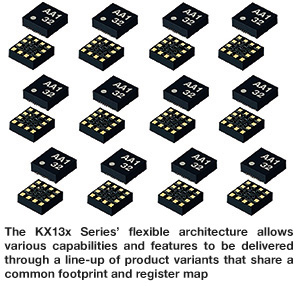A new family of accelerometers
10/04/2019
Kionix has announced the KX13x Series, a new product family of accelerometers designed to meet the needs of a wide range of applications, provide superior performance and improve the capability to accurately detect events and conditions.Targeting a wide range of applications, such as wearables and health and fitness in the consumer sector, key fobs, in-cabin and chassis applications in the automotive field and condition monitoring and predictive maintenance in the industrial market, the flexible architecture of the KX13x Series allows various capabilities and features to be delivered through a line-up of product variants that share a common footprint and register map. This enables Kionix to offer sensors prioritising different needs, including low cost, low power, high performance and high capability. Within this family of sensors, Kionix offers standard (up to 16 g) and high-g (up to 64 g) versions, wide-bandwidth models (up to 8 kHz), high-temperature types (up to 125°C), ultra-thin versions (0.6 mm) and automotive-grade (AEC-Q100-qualified) models. Other optional features include an embedded temperature sensor and an embedded pedometer. In all of these product variants the wake-up function has been designed to operate at low power (<1 µA) to allow systems to sleep, while the sensor constantly monitors for a motion event and sends an interruption when action needs to be taken. Additional integrated signal processing engines include ‘Wake-Up/Back-to-Sleep’, ‘Tilt’, ‘Directional Tap/Double-Tap™’ and ‘Free Fall’. Rounding out these capabilities are improved linearity, lower noise and buffering ability.
 “What sets these sensors apart from others on the market is the versatility they give product designers,” said Nader Sadrzadeh, Kionix’s CEO. “Our motivation for the KX13x Series was a recognition that the spread of smartphone technologies and the growth of Internet of Things (IoT) applications have resulted in a diverse set of applications that share some aspects in common (a need for motion, orientation or vibration sensing), but specific implementations often present unique needs for processing the signals. This makes it extremely difficult for any general market sensor to perfectly fit usage needs in every case. To address this challenge, we developed a flexible sensor architecture that lets us, along with the customer, tailor products to work best for the task at hand.”
“What sets these sensors apart from others on the market is the versatility they give product designers,” said Nader Sadrzadeh, Kionix’s CEO. “Our motivation for the KX13x Series was a recognition that the spread of smartphone technologies and the growth of Internet of Things (IoT) applications have resulted in a diverse set of applications that share some aspects in common (a need for motion, orientation or vibration sensing), but specific implementations often present unique needs for processing the signals. This makes it extremely difficult for any general market sensor to perfectly fit usage needs in every case. To address this challenge, we developed a flexible sensor architecture that lets us, along with the customer, tailor products to work best for the task at hand.”“The most distinguishing feature of the KX13x Series is what we are calling an ‘advanced datapath’ (ADP),” stated John Chong, Vice President of Product and Business Development at Kionix. “The ADP is a second set of outputs that can be configured to route the raw signal through multiple highly configurable filters and a root mean square (RMS) calculation engine. This allows unwanted noise and events to be filtered out and the signal of interest to be focused on. Applied to motion and vibration sensing, this enables manufacturers to make their products smarter, more aware and more usable.”